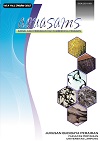POTENTIAL IMMUNOGENICITY OF BACTERIA Aeromonas hydrophila GPL-05 AND GL-02 STRAINS AS A CANDIDATE VACCINES
Abstract
Aeromonas hydrophila is very potential to be used in vaccines and disease control MAS (Motile Aeromonas Septicemia) caused by the bacteria. However, strains of A. hydrophila bacteria which have high immunogenicity limited. Not to mention, in the field often decrease the pathogenicity of the bacteria as vaccine material resulting in a decrease in the immunogenicity of a vaccine made. Therefore, it is necessary to inventory and collecting strains of A. hydrophila bacteria potentially good that vaccination continuity can be maintained. This study used an experimental method with a completely randomized design (CRD), with treatments such as P1: A. hydrophila vaccine strain GPL-05; P2: A. hydrophila vaccine strain GL-02; and P3: control (PBS), with five replicates.This study aims to assess the potential immunogenicity A.hydrophila bacterial strains as vaccine candidates. Test fish used is African catfish was about 2 months with a length of 10-15 cm and width 15-20 g. The main parameters are observed antibody titer and cross-reaction test, while supporting parameters are parameters of water quality include water temperature, pH, dissolved oxygen. Antibody titer data was analyzed by Analysis of Variance (ANOVA) and Duncan's Multiple Range Test (DMRT) at the test level of 5%, while the data and the results of cross-reaction of water quality parameters observed descriptively. The results showed that the bacteria A. hydrophila strain GPL-05 and GL-02 has a high immunogenicity, thus recommended a candidate vaccine.
Downloads
Downloads
Published
How to Cite
Issue
Section
License
License for Authors
Authors who publish with this journal agree to the following terms:
- Authors retain copyright and grant the journal right of first publication with the work simultaneously licensed under a Creative Commons Attribution License that allows others to share the work with an acknowledgement of the work's authorship and initial publication in this journal.
- Authors are able to enter into separate, additional contractual arrangements for the non-exclusive distribution of the journal's published version of the work (e.g., post it to an institutional repository or publish it in a book), with an acknowledgement of its initial publication in this journal.
- When the article is accepted for publication, its copyright is transferred to Aquasains Journal. The copyright transfer convers the exclusive right to reproduce and distribute the article, including offprint, translation, photographic reproduction, microfilm, electronic material, (offline or online) or any other reproduction of similar nature.
- Authors are permitted and encouraged to post their work online (e.g., in institutional repositories or on their website) prior to and during the submission process, as it can lead to productive exchanges, as well as earlier and greater citation of published work (See The Effect of Open Access).
- The Author warrant that this article is original and that the author has full power to publish. The author sign for and accepts responsibility for releasing this material on behalf os any and all-author. If the article based on or part os student’s thesis, the student needs to sign as his/her agreement that his/her works is going published.
License for Regular Users
Other regular users who want to cite, distribute, remix, tweak, and build upon author’s works, even for commercial purposes, should acknowledge the work’s authorship and initial publication in this journal, licensed under a Creative Commons Attribution License.
This license lets others distribute, remix, tweak, and build upon your work, even commercially, as long as they credit you for the original creation.
This work is licensed under a Creative Commons Attribution 4.0 International License.Copyright Transfer Statement can be downloaded here


.png)









